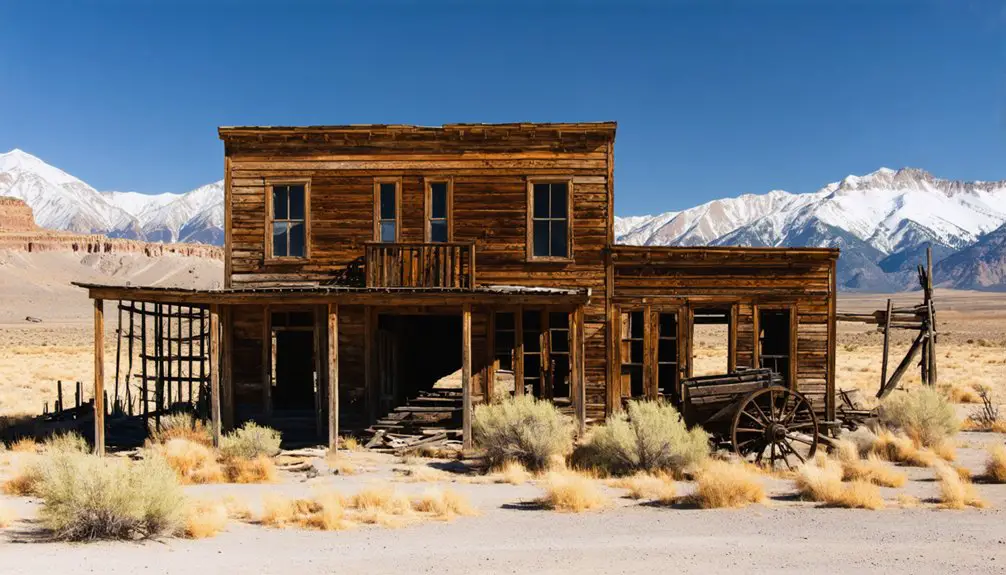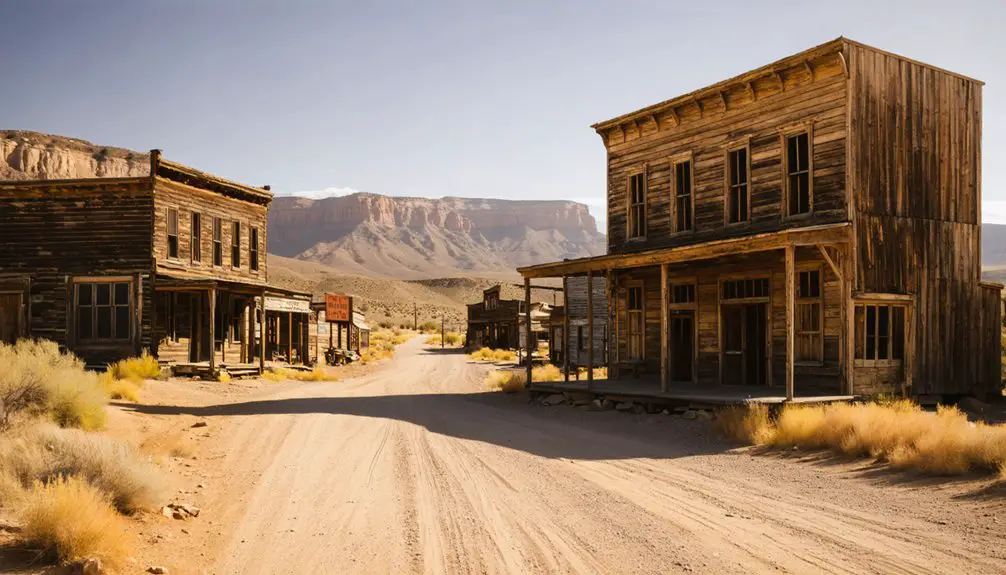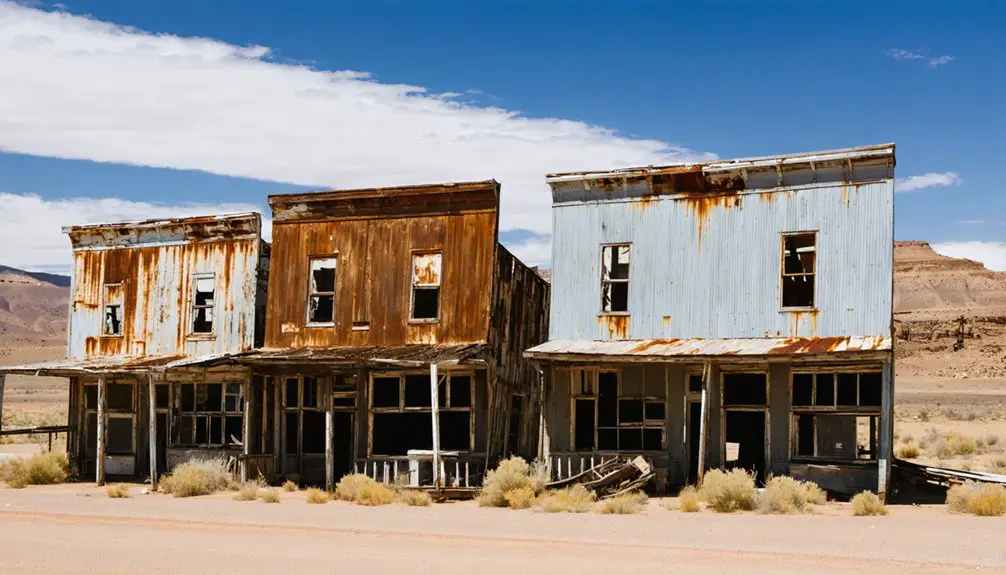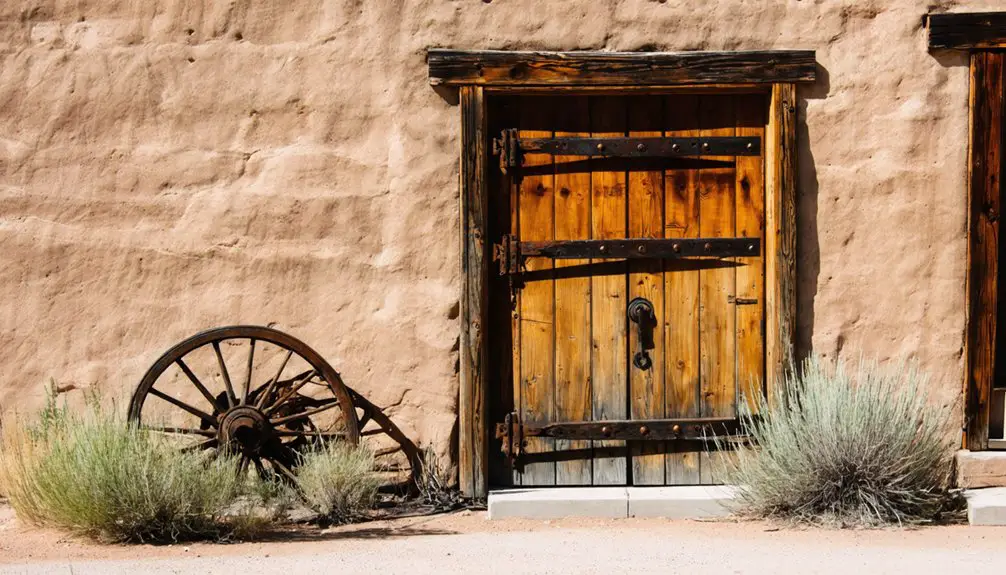You’ll find Eagle City tucked away in Utah’s Henry Mountains, where prospectors Jack Sumner and Jack Butler discovered gold in 1889. This remote ghost town, situated in Bromide Basin near Crescent Creek, quickly grew to house nearly 100 residents with stores, saloons, and stone buildings. The mining settlement thrived until 1911 when the Bromide mill burned down, marking the beginning of its decline. The town’s rugged ruins and hidden stories await in southern Utah’s backcountry.
Key Takeaways
- Eagle City was established in 1889 as a gold mining settlement in Utah’s Henry Mountains after discoveries by Jack Sumner and Jack Butler.
- At its peak, the town supported nearly 100 residents with stores, saloons, and a hotel in Bromide Basin.
- The town experienced brief prosperity during 1891-1893, producing about $15,000 in gold before declining due to ore depletion.
- Few stone buildings remain today, with the original town layout following the natural contours of Bromide Basin and Crescent Creek.
- The settlement was abandoned by World War I due to limited gold deposits, costly mining operations, and harsh living conditions.
Location and Geographic Setting
Nestled within the remote Henry Mountains of southern Utah, Eagle City stands as a tribute to the region’s mining heritage in Garfield County’s Bromide Basin.
Among Utah’s rugged Henry Mountains, Eagle City endures as a monument to the area’s gold-mining past in Bromide Basin.
You’ll find this ghost town at the head of Crescent Creek, where distinct geographic features shaped the settlement’s development. The site’s positioning roughly two miles below Bromide Basin places it at a strategic canyon fork, surrounded by rugged mountain terrain.
The town’s high elevation impact is evident in its alpine setting, where you’re surrounded by a natural amphitheater of ridges and peaks. While very little information exists about Eagle City, it remains classified as a recognized Utah entity.
While you can access the site via 2WD roads, the remote location exemplifies the untamed spirit of Utah’s backcountry. The Saw Tooth region lies 19 miles to the northeast, offering additional historical context to the area’s mining legacy. The surrounding basin’s natural drainage patterns and creek headwaters create a unique backdrop that influenced the town’s original layout and mining operations.
Early Mining Camp Origins
You’ll find Eagle City‘s origins in Utah’s remote Bromide Basin, where prospectors discovered promising gold deposits in 1889 within the Henry Mountains.
Jack Sumner and Jack Butler located the valuable Bromide Mine gold ledge, while fellow prospector John Angrove’s tragic death for his gold highlighted the area’s lawless frontier nature.
The initial settlement quickly grew around these mining claims, with early settlers constructing cabins and stone houses that formed the foundation of what would become a bustling mining camp. Much like A.J. Pritchard in Idaho’s Eagle City, these early prospectors helped establish what would become a thriving gold rush town. The town rapidly expanded with stores and saloons to serve the growing mining population.
Remote Location Discovery
Deep within the Henry Mountains of Utah, Eagle City emerged in the 1880s as a remote mining settlement on Mount Ellen’s southeast slopes.
You’ll find this forgotten town near the head of Crescent Creek, just two miles east of Bromide Basin, where isolated ecosystems and eagle sightings inspired its memorable name.
The site’s discovery marked a significant moment in Utah’s mining history when prospectors like John Angrove first uncovered gold deposits in the area.
By 1900, the town was completely abandoned as mining operations ceased in the region.
You’ll understand the town’s strategic position at the canyon fork, which served as a natural gateway to the mineral-rich Bromide Basin.
Despite its remote setting, the location proved ideal for early miners who established claims, though Angrove’s tragic death over claim disputes highlighted the area’s lawless frontier nature.
Located in Wayne County, the town’s high altitude and isolation presented unique challenges for early settlers.
Mining Claims Established
As prospectors flocked to Eagle City in the 1880s, the settlement quickly established formal mining districts to regulate claim-making activities. The district’s by-laws set strict rules for claim sizes and required minimum work to maintain claim validity, preventing speculators from hoarding land without developing it. The uranium deposits would later become the area’s primary mineral resource.
You’ll find that ownership disputes became commonplace, especially around the Oyler Mine where 75 different claims were filed between 1913 and 1937. The district recorder maintained detailed documentation of location notices, patents, and mineral certificates, which you can still research in Utah State Archives today.
When federal recognition came in 1866, it legitimized these mining districts and their regulations. By 1876, the Utah Territorial Assembly made all mining district records legally admissible in courts, strengthening claim holders’ rights. The Henry Mountain Mining District was established to help regulate the increasing number of claims following Cass Hite’s discovery of gold in Glen Canyon.
Initial Settlement Development
When prospectors discovered promising mineral deposits in Utah’s Henry Mountains during the 1880s, Eagle City emerged as a rough-hewn mining camp near Bromide Basin and Crescent Creek. You’d find the settlement tucked at the mountain’s foot, where timber and water resources proved vital for the miners’ survival. As documented in Parker Hamilton’s research, this remote Utah settlement faced numerous development challenges. Like Silver City’s early days, Eagle City first consisted of simple tents and shacks.
Despite harsh settlement challenges in the remote terrain, Eagle City grew rapidly through the early 1890s. By 1893, you’d have encountered over 100 men working the area, transforming the camp into a bustling community.
The evolving community dynamics sparked development of essential amenities – wooden cabins for housing, a hotel, two saloons, a dance hall, three stores, and a post office. Local lumber operations in Bull Creek supported the town’s construction needs, while the social venues offered miners much-needed recreation after long days underground.
Life in the Mining Settlement
Though Eagle City sprang up quickly after the 1889 gold discovery by Jack Sumner and Jack Butler, the settlement soon developed the infrastructure needed for a proper mining town.
You’d find the essentials of frontier life: a store for provisions, a doctor’s office for medical care, and a hotel for travelers. Community dynamics centered around the local saloon, where miners could unwind after long days in the mines.
The frontier settlement offered all the basics – supplies, healthcare, lodging – but the saloon remained the heart of daily life.
Social interactions weren’t limited to just the locals. The town’s remote location in Bromide Basin drew an interesting mix of characters, including reported visits from Wild Bunch riders.
Despite harsh mountain winters and the challenges of isolation, the settlement maintained a tight-knit community. Even after the mining boom faded and most residents left, stalwarts like Frank Lawler called Eagle City home for decades.
Notable Historical Events

Life in Eagle City was marked by both triumph and tragedy during its brief existence.
You’ll find the town’s early years were shaped by violent conflicts over mining claims, including the tragic death of prospector John Angrove. The area’s isolation attracted outlaws, with members of the Wild Bunch gang passing through the settlement.
The most devastating event struck in 1911 when the bromide mill burned down, dealing a fatal blow to the town’s mining operations. Without adequate firefighting resources, the disaster accelerated Eagle City’s decline.
Mining Operations and Economy
Gold mining operations in Eagle City began in 1889 after prospectors Jack Sumner and Jack Butler discovered deposits near Bromide Basin. Early mining efforts yielded about $15,000 in gold between 1891-1893, but you’ll find the town’s economic sustainability was challenged by difficult extraction conditions.
Eagle City’s gold rush launched in 1889 with Sumner and Butler’s discovery, but extraction challenges limited its economic potential.
The mining techniques evolved as miners faced increasing obstacles. Water seepage in deeper shafts made drainage costly, while limited water availability restricted placer mining operations.
When the Bromide Mill burned down in 1911, it dealt a devastating blow to the local economy. Though the town supported nearly 100 residents at its peak with businesses like stores, saloons, and a hotel, mining activity gradually ceased by WWI.
The lack of rich ore veins ultimately prevented Eagle City from establishing long-term prosperity.
Building Structures and Layout

As you explore Eagle City’s remains today, you’ll find only a few stone houses still standing from the original settlement that once included a store, hotel, doctor’s office, and saloon in the late 1800s.
The town’s layout followed the natural contours of Bromide Basin and Crescent Creek, with buildings strategically placed at a canyon fork about two miles below the main mining area.
While most wooden structures have long since deteriorated, the surviving stone buildings showcase the town’s more permanent architectural elements, demonstrating how miners shifted from temporary shelters to more substantial dwellings during the community’s peak.
Mining Cabins and Housing
When miners settled in Eagle City during the 1880s, they constructed simple wood-frame cabins that reflected the camp’s temporary nature and utilitarian needs.
You’ll find these structures were built using timber from nearby forests, with basic stone or wood foundations and straightforward gabled or shed roofs covered in wooden shingles or tin.
Most cabins were compact, under 500 square feet, featuring one or two rooms that served multiple purposes.
The cabin construction prioritized speed and practicality over comfort, with crude joinery and minimal insulation.
Living conditions were sparse – you’d have seen single walls, simple wood stoves, and basic venting systems.
The cabins clustered informally near the Bromide Basin mines, adapting to the mountainous terrain rather than following formal street patterns.
Few structures survived the harsh Henry Mountains weather after the camp’s abandonment around 1900.
Town Layout Features
The rugged canyon fork shaped Eagle City’s distinctive layout, with two primary roads forming the town’s basic infrastructure in the 1880s.
Town planning focused on essential community buildings clustered along these accessible routes, including a store, hotel, saloon, and doctor’s office that served as crucial social hubs.
The community infrastructure expanded through modular development, with concrete home pads poured in groups to accommodate future growth.
You’ll find the schoolhouse was strategically positioned near the main streets, serving kindergarten through eighth grade while doubling as a community center.
Though minimal urban planning is evident in the deteriorated street signs and basic road network, the layout allowed for efficient access to mining operations while maintaining space for residential expansion.
Construction Materials Used
Mining pioneers in Eagle City relied primarily on locally sourced materials for construction, with wood framing serving as the backbone of most 1880s structures.
You’ll find they used timber from surrounding forests for exterior siding and basic frameworks, while incorporating purple-hued stones from nearby quarries for foundations and retaining walls.
The stone masonry shows deliberate craftsmanship, particularly in building foundations and semi-subterranean storage areas.
They’d often reinforce wood framing with metal sheeting for cold storage or protection, while experimenting with early concrete composites using local stones.
The town’s builders adapted cleverly to the remote Henry Mountains environment, creating structures that balanced durability with practicality.
You can still spot remnants of their ingenuity in surviving foundations and the occasional 90-degree metal pipe protruding from the desert soil.
Reasons for Abandonment

Several interlinked factors led to Eagle City’s abandonment in the early 1900s, with economic decline serving as the primary catalyst. The depletion of the Bromide Basin mines triggered an economic collapse that left residents with no viable means of income.
You’ll find that Eagle City’s remote location in the Henry Mountains complicated any attempts to establish alternative industries. The town’s isolation made it difficult to transport goods or develop infrastructure, while harsh living conditions at high altitude discouraged long-term settlement.
With no agriculture or trade to fall back on, the single-industry mining town couldn’t sustain itself. As mining operations ceased, population migration followed swiftly, with residents relocating to more prosperous and accessible communities.
Present-Day Site Remnants
Despite Eagle City’s abandonment over a century ago, modern visitors can still explore substantial structural remnants scattered throughout the remote Henry Mountains site.
You’ll find several intact stone houses showcasing pioneer architectural styles, alongside deteriorating garages and outbuildings that occasionally contain old vehicles and artifacts from daily life.
The site retains traces of its mining heritage through remnants of 1880s cabins, flooded mine shafts, and the location of the former Bromide Mine.
While concrete foundations and building pads reveal the town’s original layout, visitor safety is a significant concern due to unstable structures and natural decay.
The rugged mountain terrain and harsh weather conditions continue to shape the ruins, with vegetation gradually reclaiming many of the remaining structures.
Frequently Asked Questions
What Native American Tribes Originally Inhabited the Eagle City Area?
You’ll find the Ute tribe was most prominent in Eagle’s native tribes and cultural heritage, followed by the Cheyenne, Arapaho, Comanche, and Paiute peoples who shared this ancestral territory.
How Many People Lived in Eagle City During Its Peak Population?
Playing it by ear, you’d find that Eagle City’s mining history suggests its peak demographics weren’t officially recorded, but based on comparable Utah mining camps, it likely reached between 100-300 residents during the 1880s.
Were There Any Significant Conflicts or Violence in Eagle City?
You won’t find records of significant conflicts or historical disputes in this peaceful mining settlement. Unlike its Idaho namesake, there aren’t any documented ghostly encounters or violent altercations from its brief existence.
What Was the Average Temperature and Climate in Eagle City?
You’d experience snowy winters below freezing and warm summers reaching the 80s°F, with significant temperature variations throughout the year. The mountain climate patterns created stark seasonal shifts in this high-altitude mining settlement.
Did Any Famous Historical Figures Ever Visit Eagle City?
You won’t find any famous visitors in the historical records of this remote mining camp. Its historical significance lies in mining operations rather than celebrity appearances during its brief 1880s-1900 existence.
References
- https://digging-history.com/2014/05/28/ghost-town-wednesday-eagle-city-idaho/
- https://onlineutah.us/eaglecityhistory.shtml
- https://www.deseret.com/utah/2024/06/03/how-to-visit-utah-ghost-towns/
- https://exhibits.lib.utah.edu/s/ghost-towns/item/140116
- https://dp.la/item/3b1131dbe5326d0e0d5824c82089768c
- https://dbpedia.org/page/Eagle_City
- https://mapcarta.com/23422938
- https://www.wikiwand.com/en/map/Eagle_City
- https://www.ghosttowns.com/states/ut/eaglecity.html
- https://www.uen.org/utah_history_encyclopedia/h/HENRY_MOUNTAINS.shtml



